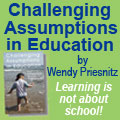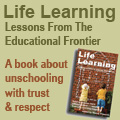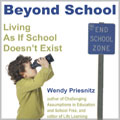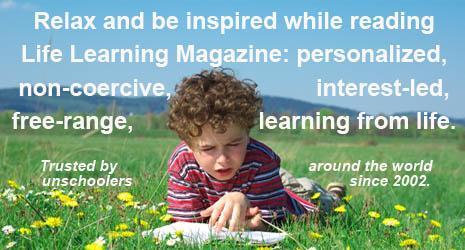|

Guidance, Not Control
By Wendy Priesnitz
“Education demands you write the script of your own life with the help of people who love or care about you.” ~John Taylor Gatto
One of the things that confounds people making the shift from schooling to school-free living is how much guidance and freedom to give children. Guidance, not control is the subject of many of the online conversations (and disagreements) among unschoolers, especially when the discussion moves beyond academics into the realm of general parenting philosophy.
I think that clarifying what we mean by control and guidance can help us decide how to live and learn with our children. The essence of life learning is to move away from controlling kids’ learning (and lives, for that matter). But the dilemma many parents experience is to figure out how much guidance children need at various stages in their development, and what our role is in relation to that. Each child and each parent will differ in their needs.
Control
The idea of controlling kids is well-established in our society. Adults routinely (and sometimes unthinkingly) make decisions for children and young people, create rules that govern their lives, and generally tell them what to study and do...and when, where, and how. At school, learning is regimented in a controlled manner, using a carefully sequenced third-party curriculum that sets out various subjects to be studied in a particular order, accompanied by lots of memorization, practice exercises, and testing.
Even those adults who believe they are treating children with respect, tact, and courtesy act in such a way. They think that children need enforced structure in order to learn, as well as limits in order to behave appropriately (the latter often relating to ways in which the former can be enforced).
As life learners, on the other hand, we try hard not to inflict our agendas onto our children, and to trust them to learn what they need to know. We understand that people learn best on an as-needed basis, and that when kids don’t have their powerful curiosity stolen or arbitrary limits imposed they will be interested in much more than we might prescribe and will behave responsibly.
Nevertheless, and especially in the early days of life learning or under pressure from others, trusting the process can be difficult. And then there are all those scary words like “authority” and “coercion” that we definitely want to avoid. So the question becomes how and when to guide children without controlling them.
One of the things to remember as you learn the difference between control and guidance/assistance is that even the most neurotic parents won’t be able to keep their kids one hundred percent safe and healthy, let alone ensure that they will learn what somebody thinks they’re “supposed” to learn. Chances are that if we give kids trust and respect, along with time and support, those things will happen, but there are no guarantees, either at home or at school.
Guidance
The good news is that even the most skeptical adults can increase their trust in children’s abilities. Look for ways in which your kids have learned without your control, and examine your role (or lack of it!) in that learning. Walking and talking are the ones that are commonly cited, but there are so many more things that children learn informally.
Our children learn some of those things completely on their own. But we often are helping out, whether we realize it or not. Let’s consider learning to walk. Most people don’t force the process, or even direct it (and most wannabe toddlers wouldn’t tolerate that anyway!). What we do is model the behavior, anticipate and trust that it will happen, create an encouraging and safe environment for it to develop, provide encouragement after the child has initiated the behavior, and celebrate success. In short, we provide guidance and help but take our cues from the child, who has already demonstrated an interest in learning the skill.
You might say we mentor our children to walk and to talk; they see us doing both, and those abilities must seem more efficient and effective than crawling and babbling. We provide guidance in the form of demonstration and inspiration. We also have a role of responsibility to keep them safe from dangers for which they don’t yet have the experience to avoid – padding sharp corners, perhaps, when they’re learning to walk, and locking up the household cleaning supplies closet, or holding their hands (or carrying them) when we’re crossing the street until they’re steady enough on their feet not to fall and are aware of traffic dangers and signals.
Guidance can also be manipulative if we’re not careful. Dictionaries define guidance as the act of leadership and giving direction, advice, or counseling; they do not say anything about consent being part of the definition. That definition also covers a broad spectrum of behaviors and at one end it can look like control rather than judiciously offered support. A child’s resistance or disinterest might be your first clue that you’ve been confusing trustful and empathic support for a child’s interest-led learning with well-meaning control about what you think they “should” be doing.
But what about a child who doesn’t know (or seem to know at a particular moment) what they want to learn, who doesn’t communicate an interest to us, or seems to just be “doing nothing”? Surely providing guidance then isn’t manipulative! Maybe or maybe not. When we trust our life learners and the learning process, we can more easily be patient with the inevitable downtimes (where information could be being processed, or the child just needs to rest and regroup). It also helps to know our child’s style of learning and the direction of their interests. That can help us provide guidance by making suggestions and pointing out things they might not otherwise have known about.
| “If you are confused, just take it one step at a time; with love, trust, respect, creativity, and empathy, you’ll find your family’s own unique way.” |
The trick is not to invest ourselves in those suggested topics or activities. One of the signs that we are trying to control someone else is that we become upset when they aren’t interested in our suggestions, or refuse to do or be what we want. In his book Unconditional Parenting, Alfie Kohn notes that “controlling parents” are actually conveying to their kids that they love them conditionally – that is, only when they “achieve” or behave in a certain approved way. Kids who live with trust and respect feel loved unconditionally and are comfortable in their own skins. Their intact self-esteem and confidence will allow them to ask us for guidance, help, or inspiration when they need it.
Influence
All parents influence their children by the mere fact of living with them, and that’s normally a good thing. Most of us want our children to be exposed to the richness of the world – music, literature, science, history, art, numbers, etc., and we use our influence to connect them to those possibilities. But we don’t use that influence as a means of control to pressure them into studying something; instead, we trust the process of self-education, and respect their right to pick, choose, explore, and set aside.
In our life learning family, conversation was one of the many ways that influence was delivered. We didn’t set up unnecessary conflicts by demanding things of our daughters that they chose not to accept; rather, through conversation, we learned about their interests, and what activities and choices would work for us all. Conversation was also the main means by which we learned when situations had become more than they could handle – and when we needed to offer help or to simply observe a less-than-ideal outcome becoming a learning experience.
Writing in a 1990 book called Understanding Children, psychologist Jerome Bruner described pedagogy as an “extension of conversation.” In homeschooling families, conversation is one of the opportunities for learning, not an extension of it. It doesn’t have to be deep conversation. In fact, in the normal flow of talk that moves naturally from one topic to another, we pick up bits and pieces of information that we fit together as needed – either then or at another time – into the jigsaw puzzle of knowledge.
Most (if not all) schools create an atmosphere of coercion, mistrust, and manipulation, which undermines learning (among other things). Real, meaningful, lasting learning can only take place when the learner wants it to. No matter where we are on the life learning spectrum (and the conventional notions of “permissiveness” and “authoritarianism” have no place there), we are designing new ways for our children to live and learn with our guidance and help. If you are confused, just take it one step at a time; with love, trust, respect, creativity, and empathy, you’ll find your family’s own unique way.
Learn More
“Principles Not Rules: Living & Learning in the Real World” by Robyn Coburn, Life Learning Magazine, November/December 2005
“Freedom or Control: Kids’ Right to Live and Learn in Freedom” by Wendy Priesnitz, Life Learning Magazine, July/August 2004
Wendy Priesnitz is Life Learning Magazine's founding editor. A writer and journalist for forty years, she is the author of thirteen books, a former broadcaster, and a lifelong changemaker. She and her husband helped their two now-adult daughters learn without school in the 1970s and '80s. You can learn more about her and read more of her writing on her website.
Copyright © Life Media
Privacy Policy
  
  

|

